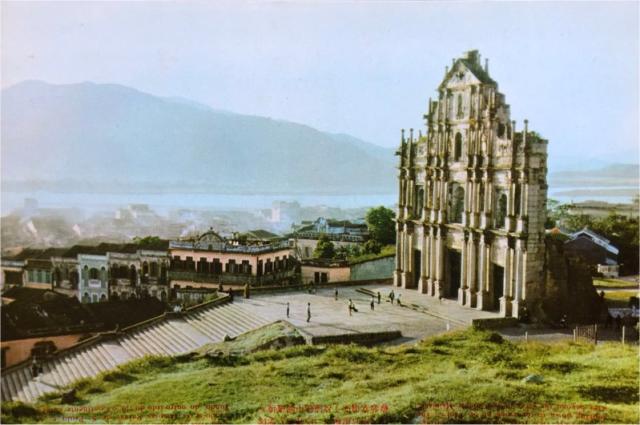The description on the message side of this postcard purchased new in 1970 reads: A bird’s-eye view from the old Monte Fortress, looking down to the ruins of St Pauls. The area beyond the river is the Chinese Mainland.
A 1930 Macao Department of Economic Researches, Publicity and Information Bureau brochure inviting “Round the World” cruise passengers to “include a trip to Macao - the oldest foreign colony in China – founded in 1557 – three and a half hours from Hong-Kong” as a part of their tour itinerary. The brochure goes on to describe the “ruined South Front of St Paul’s Church” in the following informative terms: “The first Church to be built on this site was Virgini Magna Matri Civitas Macaensis Lubens Posuit in 1602, as its foundation stone attests. The stone façade, which stands as a hoary ruin today, was built in 1638, the artisans being Japanese Christians. It is covered with a mass of carvings in high relief and was considered to be a wonder of the time. The flight of steps leading up to the church had also excited admiration. Along the lowest of three tiers are niched four statues of Jesuit Saints, notably St Francis Xavier, as inscribed on their pedestals. The central tier contains a statue of the Virgin Mary in the centre, flanked by angels in prayer, the fountain and the tree of life, a ship and a gorgon, an Apocalyptic monster, and a skeleton dormant. In the uppermost tier, surrounded by the objects used in the Crucifixon, stands a representation of Jesus Christ with the Dove, symbol of the Holy Ghost; and Sun, Moon and Stars, topped by the cross of Jerusalem. Though generally called St Paul’s Church, it was as the Church of the Mother of God that it was built, as the words Mater Dei over the doorway testify. Attached to the church there used to be a famous college and seminary, whence went forth into China and all over the Far East, hundreds of missioners to preach the Gospel of Christ. This building was burnt down in 1835, and fire spreading to the church destroyed it also; leaving the old ruin standing as it may be seen today.”
During November 1959 the popular British author Ian Fleming, in company with Dick Hughes, Hong Kong resident and Far Eastern correspondent of London’s Sunday Times, travelled by the S.S. Takshing to Macau. The Australian, Hughes, who in select Hong Kong circles was sometimes referred to as The Cardinal, was surprisingly knowledgeable about many things Catholic; and of their shared pilgrimage to visit the ruins of St Paul’s Church, Fleming somewhat colourfully recalls: “We admired the awe-inspiring façade of St Pauls upon which the Japanese Christian stonemasons had sprinkled plenty of dragons and flying skeletons amongst the angels.”
